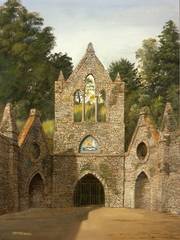Modern paganism contains a wide range of traditions informed by pre-Christian beliefs, often with an emphasis on ritual practice and respect for the natural world. Weird Walk have curated five of their favourite winter walks connected with the evolution of modern paganism, that emanate with powerful vibes to this day.


1. The Hellfire Caves, West Wycombe
Sir Francis Dashwood is remembered as a notorious eighteenth-century LAD and short-lived Chancellor of the Exchequer. Inspired by his tours of Europe, he formed a society parodying monastic orders, posthumously dubbed the Hellfire Club in honour of its nefarious activities. The members often pitched up at Medmenham Abbey, where their hi-jinks were described by a contemporary as “rigorously pagan: Bacchus and Venus were the deities to whom they almost publicly sacrificed.” Dashwood also ordered the excavation what came to be known as the Hellfire Caves near his ancestral seat in West Wycombe, and the remarkable chambers can still be visited today. In his enthusiasm for classical paganism and ritual, Dashwood would influence later practitioners, such as Aleister Crowley – the Hellfire Club motto was “Do what thou wilt”.


2. Anglesey Druids Way, North Wales
Anglesey is famed as the last stronghold of the Druids in Britain before they were eventually overcome by the might of Rome. It is a magical place, dense with wondrous prehistoric monuments and epic seascapes. When the Druid revival began in the eighteenth century, it is unsurprising that their old haunt was an early adopter, with the Druidic Society established on Anglesey in 1772. Initially, the revived Druids were more into poetry, ale and good fellowship than religious practices, but this early interest in ancient British spirituality pointed the way to later developments in paganism, and Druidry continues to be found on Anglesey today.


3. The Chalice Well Gardens, Glastonbury
The Somerset town of Glastonbury has a good claim to being the centre of modern paganism in Britain, as only a cursory stroll down its high street packed with wondrous esoteric independent shops will attest. The beautiful Chalice Well Gardens contain the Red Spring, speculatively identified as the spot where Joseph of Arimathea sank the Holy Grail following Christ’s death. This mythic location, like many in Glastonbury, speaks to a New Age unification of Christian and pagan ideas, a place of contemplation and acceptance below the potent shape of the Tor.


4. The New Forest, Hampshire
The story of Gerald Gardner, the founder of Wicca and the father of modern witchcraft, is profoundly linked to the New Forest. It was while living in Highcliffe, on the edge of the ancient hunting forest, that he claimed to have been initiated into a coven of witches whose lineage stretched back to the pre-Christian period. It was from this secretive group, Gardner asserted, that he came to understand what is now known as Wicca. Although revealing little about the New Forest coven in his writings, Gardner noted that during the second world war the witches performed Operation Cone of Power in the forest itself, an attempt to prevent a Nazi invasion by magical means.


5. The Rollright Stones, Oxfordshire
There has long been overlap between pagans and earth mysteries enthusiasts. Perhaps nowhere is this more evident than at the vibe-filled complex of the Rollright Stones, on the border of Oxfordshire and Warwickshire. The megaliths here were key to the Dragon Project, a mission to “detect by quantifiable physical and biological means, the manifestation of earth energy at prehistoric sites”. Popular with dowsers, and linked to at least three ley lines, the Rollrights are also frequented by a number of pagan groups, including the Cotswold Order of Druids, who celebrate the summer solstice at the site.
Look out for our new collaborative capsule with Weird Walk, coming soon...














































































